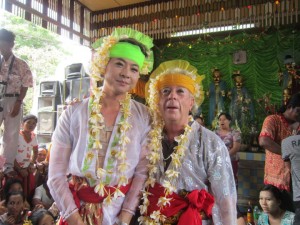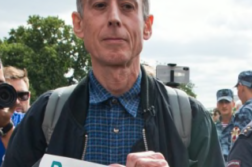IN AUGUST, 2010, I traveled from my home in Bangkok to Mandalay, finally to visit the Taungbyon Nat Pwe. Stories have circulated about this “gay” event, but nothing very coherent was available.
Myanmar or Burma, as it used to be known (and still is in some quarters) is a predominantly Buddhist country. The largest ethnic group, the Bamar (whence the name “Burma”), occupies the central areas of the country around the old royal capital of Mandalay, and south to Yangon and the delta. The first Burmese kingdom was founded in Bagan in this central region, by King Anawratha, who reigned from 1044 to 1077.
 Anawratha was a convert to the Theravada branch of Buddhism and made it the national religion. But the worship of local spirits, called Nats, could not be eliminated. So Anawratha institutionalized Nat worship but made it subordinate to Buddhism. On the grounds of his beautiful Shwezigon Paya (stupa) in Bagan, Anawratha installed a pavilion to the 37 Lords. Each, it is said, was a powerful person who died tragically. Their tragic deaths excluded them from the cycle of rebirth, with the result that their spirits are still present, for good or for evil. They need to be propitiated, and they can be invoked. Today, most Buddhist temples in Myanmar have a Nat shrine within the temple complex.
Anawratha was a convert to the Theravada branch of Buddhism and made it the national religion. But the worship of local spirits, called Nats, could not be eliminated. So Anawratha institutionalized Nat worship but made it subordinate to Buddhism. On the grounds of his beautiful Shwezigon Paya (stupa) in Bagan, Anawratha installed a pavilion to the 37 Lords. Each, it is said, was a powerful person who died tragically. Their tragic deaths excluded them from the cycle of rebirth, with the result that their spirits are still present, for good or for evil. They need to be propitiated, and they can be invoked. Today, most Buddhist temples in Myanmar have a Nat shrine within the temple complex.
The largest Nat Pwe, honoring two Nat brothers, is held in Taungbyon, close to Mandalay, each August (the exact dates depending on the lunar calendar). There were probably 2,000 people at this Pwe each day in 2010, making a total for the full week of well over 10,000 visitors. Regular police kept order and directed the chaotic traffic. A few foreigners were there.
The signature events at Nat Pwe are dances by the Nat Kadaw and other devotees to entertain the Nats. With the help (and prodding) of our local gay guide, my companion and I were dressed as the two Taungbyon brothers in fabulous outfits and heavy makeup. We were booked for one hour in one of the many ritual pavilions where we would dance for the brothers. We were not pretending to be spirit mediums, just devotees of the Nats. A small orchestra played loud, cacophonous Nat music on traditional instruments. Our delighted audience crowded into the pavilion or watched on the side—as occurred in all of the dancing events that we witnessed at the Nat Pwe. We seemed not particularly exceptional.
A senior Nat Kadaw told us that seventy percent of the spirit mediums are men, and that essentially all of them are gay. Some accounts of the Nat Pwe suggest that over time the spirit mediums have increasingly been men and those men have been increasingly been described as transvestites or gay. Certainly my friend and I had been welcomed into a grouping of gay males, who arranged for the dancing, rented our costumes, and did our makeup. I saw Tom lesbians in other parts of Myanmar, but not at the Nat Pwe.
The Taungbyon Nat Pwe seemed to have a dual personality. There were effeminate and cross-dressing males. But the crowds at the festival were basically sex and gender normative. Big stage shows were held each night, for which expensive tickets were required. They were MTV-style contemporary popular music events, with well-known Myanmar pop artists—no cross-dressing; no Nat music.
My companion and I also visited Yangon, the largest city (and former capital). There are two large gay-friendly discos—with about half the customers seeming to be gay. The image was largely of gender-normative gay men at the discos, with some transgender as well. Near one disco, named 369, was an overhead walkway known as “the bridge” famous for cruising and rent-boys. Three movie theaters were pointed out as cruisy. A tea house and toilet near Sule Pagoda was also identified as interesting. Free condoms were found in the toilet along with pamphlets on safe sex. Despite economic sanctions against the military regime, Western-funded AIDS projects are active in Myanmar.
Douglas Sanders is professor of law emeritus at the University of British Columbia, Vancouver.




